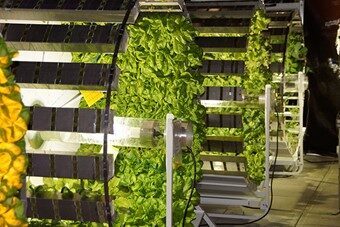The urban environment is subject to challenges that will only intensify in response to global warming. Our ability to manage runoff is reaching its limit, and experts suggest that runoff volumes can be reduced by maximizing infiltration as a control mechanism. Another major urban phenomenon is the formation of heat islands, where temperatures are 5 to 12 °C higher. Incorporating vegetation into honeycomb pavement may prove to be a natural and effective solution to these issues.
Project overview:
Aux Aubépines, a business that produces over 1,100 varieties of perennials, seeks to network with experts to develop new niches. Against the backdrop of an increasingly challenging market, the business sees green pavement as a new opportunity.
They have teamed up with Permacon, a company that has developed a honeycomb concrete paver over the past few years that is designed to be used in permeable green pavement for driveways and walkways. This new generation of honeycomb pavers addresses current sustainable development challenges involved in managing rainwater and heat islands.
Incorporating plants into these systems is difficult in northern climates. Honeycomb pavement requires plants that are particularly tolerant to drought, significant temperature fluctuations, low availability of substrate for root development, treading and the possible lack of a protective covering of snow. Despite their tolerance to treading, grasses have limited potential due to their water and fertilizer needs.
The projects therefore aimed to offer a better option by identifying hardy ground cover species that are very drought-tolerant and require little fertilizer. They also sought to improve honeycomb substrate composition to achieve sufficient stability and water-holding capacity. A selection of 11 herbaceous perennials and two grass mixes were matched with two substrates and two installation strategies.
Two types of foundation on which the pavement was installed were also tested.
Results obtained:
This issue can be addressed by installing hardy plants with minimal water and fertilizer needs in this type of pavement. However, the plants’ winter survival remains to be tested, particularly when the pavement is plowed.
When exposed to full sun, plants installed in this type of pavement have much smaller leaves than those planted entirely in soil. This is how plants adapt to a harsh environment.
Consumers will have their choice of plants that have shown strong potential and the Aux Aubépines nursery will be able to offer an exciting mosaic of plants in an enticing array of colours and textures.
Through testing we have also identified the best method for incorporating plants and determined which of the three substrates creates the most durable installation. Foundation type had little effect throughout the year of installation.
Ne s’agit-il pas de DEUX substrats, et non trois? Voir cette phrase deux paragraphes avant « Résultats obtenus : » : « Une sélection de 11 plantes herbacées vivaces et de deux mélanges à gazon ont été associés à deux substrats ».






